10 Days Ganden to Samye Trekking TourEnquiry
Tibet is one of the world’s great travel destinations and what better way to experience it than by trekking through the amazing countryside.
MOST IMPORTANT – During this trek you will be hiking at an altitude of over 4300 metres with one pass at 5250 metres. Read up about altitude sickness and be prepared with medicines and extra oxygen. An adequate level of fitness is a prerequisite.
Destinations
Lhasa – Ganden Monastery – Samye Monastery – Tsedang – Lhasa
Highlights
Potala Palace, Jokhang Temple, Barkor Street, Drepung Monastery, Sera Monastery, Ganden Monastery, Trekking to Samye Monastery, Tsedang, Yumbulakang Palace, Gongburi Mountain
Itinerary Day By Day
Day 1 – Arrival in Lhasa
Lhasa is the capital of Tibet and is located at an altitude of 3,650 metres. Because of its remoteness it has long been a ‘must see’ place for adventurous travellers. It has over 1300 years of cultural and spiritual history and is a centre for Tibetan and Buddhist culture in China.
Upon arrival at Gongkar Airport you will be met by your local guide and driver. The airport is located 70 kilometres from Lhasa so you will have the opportunity to enjoy some magnificent scenery on the way to your hotel. The remainder of the day is for relaxing and acclimatizing to the altitude. Drink plenty of water and don’t overexert yourself.
Overnight in Lhasa. (3658m)
Meals: No meals provided
Day 2 – Lhasa
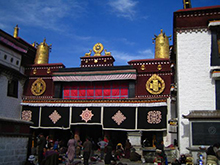
Attractions: Potala Palace, Jokhang Temple, Barkhor Street
No tour to Lhasa is complete without visiting the Potala Palace and that is where your tour will begin today. The Potala Palace is one of world’s most famous buildings and it is an impressive sight as it towers above Lhasa. The Red Palace contains various chapels and mausoleums for previous Dalai Lamas while the White Palace was the living quarters for successive Dalai Lamas and their tutors. Altogether it is a vast awe inspiring maze of corridors and rooms full of articles pertaining to Tibetan history, religion, culture and arts.
The Jokhang Temple is Tibet’s spiritual centre and the ultimate pilgrimage destination for Tibetan Buddhists. It was originally built in 647AD and has been added to over the years making it a mix of Han, Tibetan and Nepalese architectural styles. You will see many pilgrims prostrating themselves at the entrance.
Finish your day with a lap around the Barkor Street ‘kora’ or pilgrim circuit. It is a photographer’s paradise with marvellous wares for sale to crowds of exotically dressed pilgrims. Spiritual souvenirs and pilgrim accessories line the circuit and you can buy anything Tibetan from yak butter to prayer flags and turquoise jewellery. It is a place you can return to again and again for continually changing experiences. Out of respect for the pilgrims you should always move in a clockwise direction.
Optional program: In the evening your guide can take you to enjoy a local Tibetan performance.
Meals: Breakfast at your hotel
Day 3 – Lhasa

Attractions: Drepung Monastery, Sera Monastery
Your day’s tour will begin at Drepung Monastery, the largest of all Tibetan monasteries and at its peak was the largest monastery of any religion in the world with 7,700 monks in attendance. Dating from 1416 it was known for its high standards of academic excellence.
In the afternoon you will visit the magnificent Sera Monastery. The highlight here is watching the debating monks. Every afternoon at 3.00pm (except Mondays) there is a debate about Buddhist doctrines in the shady courtyard behind the main temple. The red robed monks gather in small groups to practice their debating skills in a very dynamic and lively manner with clapping sounds and aggressive expressions. Tourists are welcome to watch quietly and respectfully from the edges.
Both Drepung and Sera are Gelugpa (Yellow Hat) sect monasteries.
Meals: Breakfast at your hotel
Day 4 – Lhasa

Attractions: Ganden Monastery
Sixty kilometres from Lhasa, Ganden Monastery is the largest of the Buddhist Gelupa sect and is three times the size of the Potala Palace. It is located at an altitude of 4,500 metres and offers a fabulous view of the Kyi Chu Valley. One of the highlights of your visit will be the chance to walk the hour long pilgrimage route. Aside from the amazing views you will learn about the Tibetan culture and religion as you pass prayer flags and rock faces rubbed with yak butter offerings.
You can relax and acclimatize to the high altitude while your guide prepares for the trek.
Overnight at Ganden Monastery Guesthouse (4,500m)
Meals: Breakfast at your hotel
Day 5 – Trekking from Ganden to Yama Do
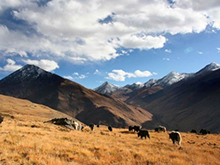
(17kms trekking – 5 to 6 hours – 450m descent, 300m ascent)
The trek begins from a high point on the Ganden Monastery kora and continues to climb up to a saddle. Here you have views down the Kyichu Valley back towards Lhasa before following the track along the ridge to the ancient village of Hepu. After the village look out for the Shrine of the Divine White Yak. At Ani Pagong the trail narrows and passes the remains of a small nunnery. Finally you arrive at the meadows of Yama Do where you might find some nomad families.
Overnight camping at Yama Do.
Day 6 – Trekking from Yama Do to Chitul Gang
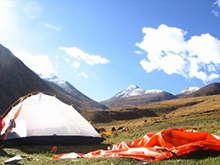
(10kms trekking – 5 to 7 hours)
This morning the track leaves the valley and heads up a steep gully to finally arrive at Shug La Pass which at 5250 metres is the highest point on the trek. You may find that you need to walk more slowly in the thinner air. Coming down from the pass is also slow as you make your way through fields of glacial boulders. Finally you will arrive at the Tsotup Chu River and camp in the meadows among the nomad herders.
Overnight camping at Chitul Gang.
Day 7 – Trekking from Chitul Gang to Herder’s Camp
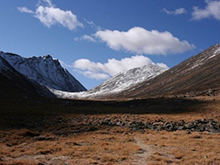
(14kms trekking – 5 to 6 hours)
Today you will cross another pass. Chitu La Pass is lower than yesterday’s height but at 5,100 metres it is still a challenge. A beautiful lake and valley views will be your reward for your effort. Once again you will camp in meadows near nomad herders.
Overnight camping at Herder’s Camp.
Day 8 – Trekking from Herder’s Camp to Samye Monastery
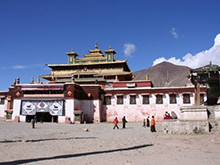
(20kms trekking – 4 to 5 hours)
Attractions: Trekking, Yarmalung Heritage, Samye Monastery, Tsedang
Today’s hike is longer but easier than the other days as the trail widens through green valleys to Changtang, the first permanent village since Hepu. On a nearby hillside is the Buddhist meditation site of Yarmalung. From here you can take transport to Samye Monastery.
Samye Monastery has a history of over 1,200 years and was the first Buddhist monastery built in Tibet. It is laid out in the form of a huge mandala which is the Buddhist representation of the world. The main temple symbolises the centre of the universe while other stupas represent the four continents. It is a very popular pilgrimage destination for Tibetan Buddhists.
Then you will drive to Tsedang which was the ancient capital of Tibet prior to Lhasa.
Overnight at Tsedang (3515m)
Day 9 – Tsedang
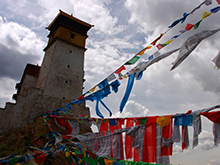
Attractions: Yumbulakang Palace, Gongburi Mountain
In the morning you will visit is the Yumbulakang Palace which is perched on the summit of a small hill in Yalung Valley. According to legend it was built in the second century BC for the first Tibetan king who had descended from the sky. You can ride a horse up the hill to the palace (extra fee) or walk up. There is an excellent view from the top.
Finally you will visit the Monkey cave on the Holy Gongburi Mountain, one of the four great magic mountains in Tibet. Legends say that the holy mountain is supported from underneath by four gods, i.e. the horse king in the east, a Buddha figure in the west, a peacock in the north and a spirit turtle in the south. There is also a legend connected with the Monkey Cave concerning how the Tibetan people are descended from an ape.
The plain below the mountain is said to be a playing place for monkeys, therefore it is called Tsedang which means ‘a plain for playing’.
Meals: Breakfast at your hotel
Day 10 – Depart Tibet
Today you will have some free time in the morning before being transferred to Lhasa Airport for your flight to your next destination.
Meals: Breakfast at your hotel

